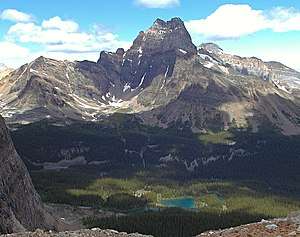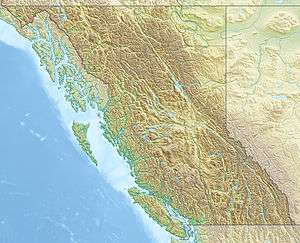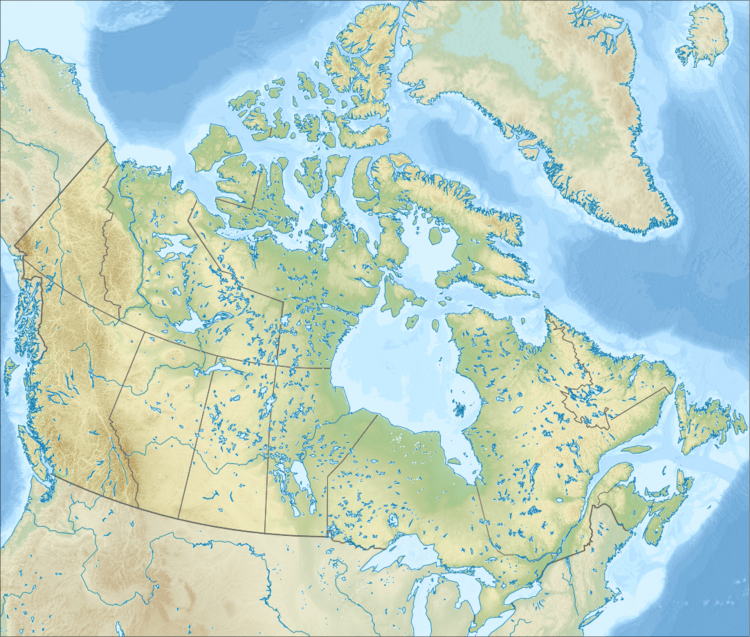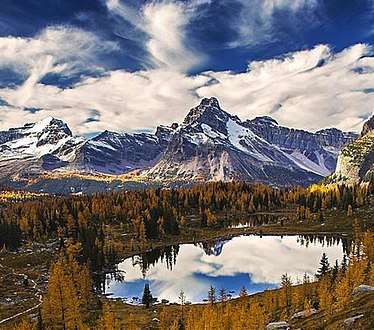Cathedral Mountain (Yoho)
Cathedral Mountain is a 3,189-metre (10,463-foot) complex massif located six kilometres northwest of Lake O'Hara in Yoho National Park, in the Canadian Rockies of British Columbia, Canada. Its shape and structure conjures up a resemblance to a gothic cathedral that has inspired many artists, including Group of Seven's Arthur Lismer, to paint it back in 1928. This picturesque mountain is visible from Highway 1, the Trans-Canada Highway near Kicking Horse Pass. Its nearest higher peak is Mount Stephen, 3.0 km (1.9 mi) to the west.[2] To prevent damage to its operations, CP Rail pumps overflow from Teacup Lake down the west face of Cathedral in order to minimize the subglacial lake's discharging in a phenomenon known as a jökulhlaup.[2]
| Cathedral Mountain | |
|---|---|
 Cathedral Mountain | |
| Highest point | |
| Elevation | 3,189 m (10,463 ft) [1] |
| Prominence | 467 m (1,532 ft) [2] |
| Parent peak | Mount Stephen (3199 m)[2] |
| Listing | Mountains of British Columbia |
| Coordinates | 51°23′48″N 116°23′25″W [3] |
| Geography | |
 Cathedral Mountain Location of Cathedral Mountain in British Columbia  Cathedral Mountain Cathedral Mountain (Canada) | |
| Location | British Columbia, Canada |
| Parent range | Canadian Rockies |
| Topo map | NTS 82N08[3] |
| Geology | |
| Age of rock | Cambrian |
| Type of rock | sedimentary rock |
| Climbing | |
| First ascent | 1901 James Outram, Joseph Bossoney, and Christian Klucker (guide)[2] |
History
The name Cathedral Mountain was in use as early as 1884 and appeared on George Dawson's 1886 map.[4] The first ascent of Cathedral Mountain was made in 1901 by James Outram, with guides Joseph Bossoney, and Christian Klucker.[4] The mountain's name became official in 1924 when approved by the Geographical Names Board of Canada.[3]
Geology
Cathedral Mountain is composed of sedimentary rock laid down during the Precambrian to Jurassic periods.[5] Formed in shallow seas, this sedimentary rock was pushed east and over the top of younger rock during the Laramide orogeny.[6]
Climate
Based on the Köppen climate classification, Cathedral Mountain is located in a subarctic climate with cold, snowy winters, and mild summers.[7] Temperatures can drop below −20 °C with wind chill factors below −30 °C. Precipitation runoff from Cathedral Mountain drains into tributaries of the Kicking Horse River which is a tributary of the Columbia River.
Cathedral Crags
Cathedral Crags[8] (3082 m) are striking pinnacles with steep, reddish cliffs located one kilometre northwest of the summit of Cathedral Mountain, near Kicking Horse Pass and the Spiral Tunnels Viewpoint.[9] This rocky feature of Cathedral Mountain was first climbed in 1900 by James Outram, and W. Outram, with Christian Hasler Sr. as guide.[4] The crag's name became official in 1952 when approved by the Geographical Names Board of Canada.[8]
References
- "Cathedral Mountain, Canada". Peakbagger.com. Retrieved 2019-09-10.
- "Cathedral Mountain". Bivouac.com. Retrieved 2018-11-17.
- "Cathedral Mountain". Geographical Names Data Base. Natural Resources Canada. Retrieved 2018-11-17.
- "Cathedral Mountain". PeakFinder.com. Retrieved 2019-10-09.
- Belyea, Helen R. (1960). The Story of the Mountains in Banff National Park (PDF). parkscanadahistory.com (Report). Ottawa: Geological Survey of Canada. Archived (PDF) from the original on 2015-10-02. Retrieved 2019-09-13.
- Gadd, Ben (2008). Geology of the Rocky Mountains and Columbias.
- Peel, M. C.; Finlayson, B. L. & McMahon, T. A. (2007). "Updated world map of the Köppen−Geiger climate classification". Hydrol. Earth Syst. Sci. 11: 1633–1644. ISSN 1027-5606.
- "Cathedral Crags". Geographical Names Data Base. Natural Resources Canada. Retrieved 2019-01-09.
- "Cathedral Crags". Bivouac.com. Retrieved 2019-01-09.
Gallery
 Cathedral Mountain with Hungabee Lake
Cathedral Mountain with Hungabee Lake%2C_3073m_(7897953842).jpg) Cathedral Crags
Cathedral Crags
See also
External links
- Cathedral Mountain Weather forecast
- Parks Canada web site: Yoho National Park
- Arthur Lismer's painting of Cathedral Mountain: Art History
- J. E. H. MacDonald's 1927 painting of Cathedral Mountain: Wikimedia Commons